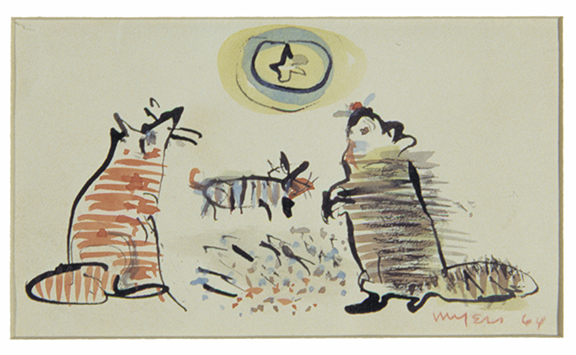 Recognized as one of America’s foremost printmakers, Malcolm Myers ’40 (1917-2002) liked to make things new. “I have a fear of repeating things too much,” he once said. “I like to try new things, new motifs.”
Recognized as one of America’s foremost printmakers, Malcolm Myers ’40 (1917-2002) liked to make things new. “I have a fear of repeating things too much,” he once said. “I like to try new things, new motifs.”
During his lifetime of artistic pursuits, he not only pioneered new techniques in printmaking but also explored a universe-wide set of artistic themes, ranging from jazz to landscapes to knights in shining armor. “The Journey,” “The Magic Forest” and “Hundred-Guilder Print” are among his most widely known works.
Born in Missouri in 1917, Malcolm H. Myers ’40 died March 14 in Minneapolis. The artist who once held the 120-yard high hurdles and the 220-yard low hurdles records at the University of Wichita went on to earn two master’s degrees from the University of Iowa. As a longtime art professor and former chairman of the art department at the University of Minnesota, Myers was called “an artistic institution.”
Wichita State honored him in 1973 with the presentation of the alumni association’s Alumni Achievement Award, the first given to an artist. Among his most characteristic subjects are medieval knighthood, animal and Wild West figures and religious themes.
Another of his artistic explorations focused on jazz, with which his work shares the characteristics of spontaneity and improvisation. Known for the eloquence and fantasy of his prints and considered one of the nation’s foremost printmakers, Myers also was a noted watercolorist.
He won two Guggenheim Fellowships, the first of which allowed him to study in Paris in 1951. For the second, awarded in 1954, he studied in Mexico City. Works of his art are held in the permanent collections of, among others, the Museum of Modern Art, Biblioth`eque Nationale in Paris, Minneapolis Art Institute, Seattle Art Museum, St. Louis Art Museum, Library of Congress, Wichita Art Museum and WSU’s Ulrich Museum of Art, where the artworks featured here reside.






